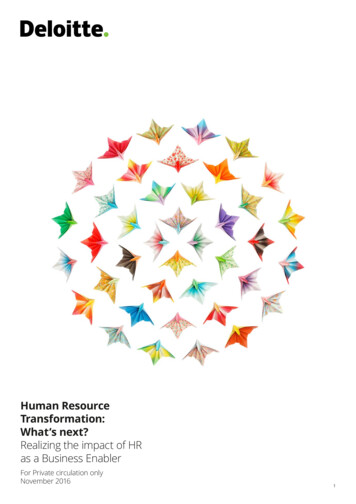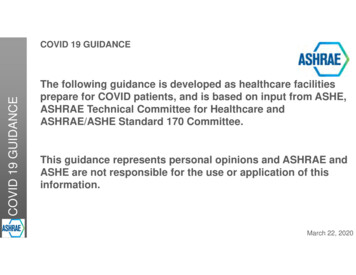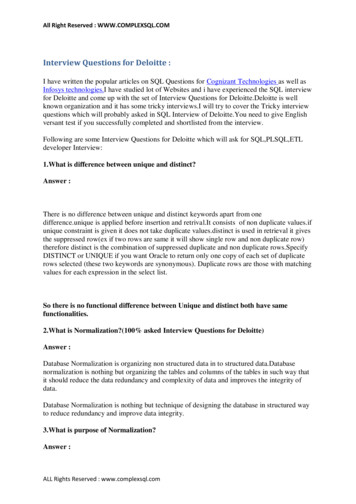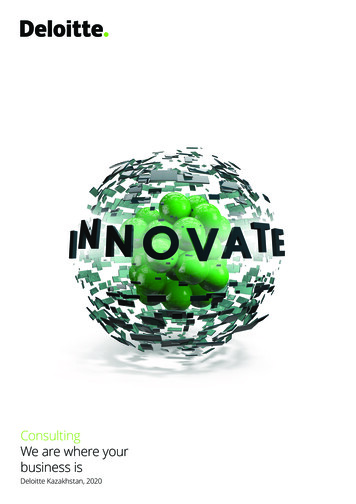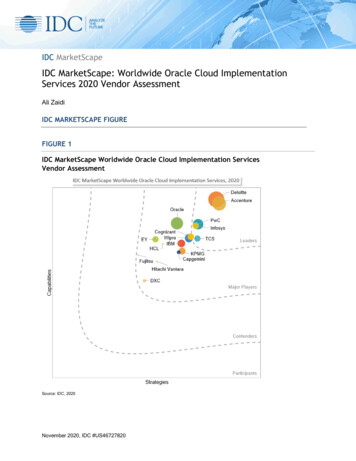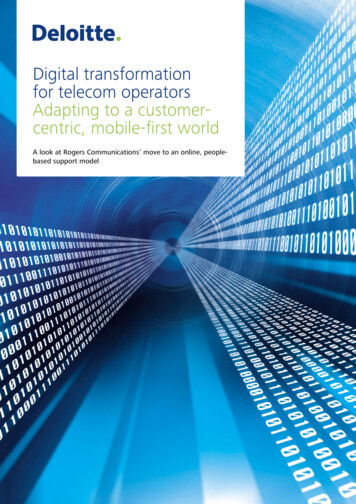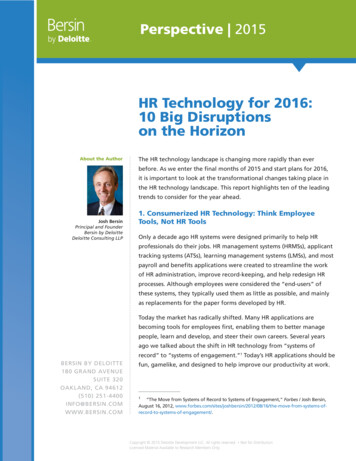
Transcription
Perspective 2015HR Technology for 2016:10 Big Disruptionson the HorizonAbout the AuthorThe HR technology landscape is changing more rapidly than everbefore. As we enter the final months of 2015 and start plans for 2016,it is important to look at the transformational changes taking place inthe HR technology landscape. This report highlights ten of the leadingtrends to consider for the year ahead.Josh BersinPrincipal and FounderBersin by DeloitteDeloitte Consulting LLP1. Consumerized HR Technology: Think EmployeeTools, Not HR ToolsOnly a decade ago HR systems were designed primarily to help HRprofessionals do their jobs. HR management systems (HRMSs), applicanttracking systems (ATSs), learning management systems (LMSs), and mostpayroll and benefits applications were created to streamline the workof HR administration, improve record-keeping, and help redesign HRprocesses. Although employees were considered the “end-users” ofthese systems, they typically used them as little as possible, and mainlyas replacements for the paper forms developed by HR.Today the market has radically shifted. Many HR applications arebecoming tools for employees first, enabling them to better managepeople, learn and develop, and steer their own careers. Several yearsago we talked about the shift in HR technology from “systems ofrecord” to “systems of engagement.”1 Today’s HR applications should beBERSIN BY DELOITTE180 GRAND AVENUESUITE 320OAKLAND, CA 94612(510) 251-4400INFO@BERSIN.COMWWW.BERSIN.COMfun, gamelike, and designed to help improve our productivity at work.1“The Move from Systems of Record to Systems of Engagement,” Forbes / Josh Bersin,August 16, 2012, Copyright 2015 Deloitte Development LLC. All rights reserved. Not for DistributionLicensed Material Available to Research Members Only.
Perspective 2015Look at recruitment, for example. Traditional ATSs were used to store,score, track, and manage resumes. Today’s talent acquisition systemsare often called “recruitment success platforms,” designed to enableapplicants, managers, and recruiters to do a better job. These moreintegrated systems allow applicants to apply for jobs through mobiledevices and interview through online video, as well as help managersmake sure they are selecting the best candidate.Consider learning management systems. Once intended to help managethe administration of learning, today’s online learning systems aretruly “learning experience platforms,” designed to help people explorelearning opportunities, learn online, find certification and testingprograms, and collaborate with experts.In the area of performance management, most traditional HR softwarehas become overly complex and time-consuming (only 12 percent ofcompanies report their performance process is worth the time theyput into it2). Today these systems are being reimagined as tools foremployee check-ins, self-assessment, as well as for feedback betweenmanagers and employees.KEY POINTMany companiesare rippingout decades ofinvestment inlast-generationERP systems andreplacing themwith tools that candirectly empowerThis shift—away from HR and toward the employee as the user—hashad a huge impact on the market. Vendors that focus only on backoffice functionality and which don’t have any compelling mobile appsare likely to lose ground. Many companies are ripping out decadesof investment in last-generation enterprise resource planning (ERP)systems, replacing them with tools that can directly empower managersand employees. Startups that are born on the web are often displacingcompanies that have been selling HR software for years.We see a whole new market of mobile- and cloud-first apps starting toemerge, giving us a sense that most of our HR solutions will be runningon our mobile phones, offering built-in location awareness, sensors, andeven bio-monitoring tools.managers andemployees.Imagine an employee application suite that runs on your phone,knows your location, and recommends people to network with.2Global Human Capital Trends 2015: Leading in the new world of work, DeloitteDevelopment LLC and Deloitte University Press, 2015, R Technology for 2016: 10 Big Disruptions on the HorizonJosh Bersin Page 2Copyright 2015 Deloitte Development LLC. All rights reserved. Not for DistributionLicensed Material Available to Research Members Only.
Perspective 2015It provides continuous onboarding and transition assistance,evaluates time-management aptitude to help improve productivity,automatically assesses work behaviors and offers feedback onimproving work-life balance, delivers on-the-job skills training, andeven shares exercise and healthy eating tips at the point of need. Thisis likely where HR technology is going, and we’re getting there a lotfaster than you might think.As companies look to upgrade and replace their HR technologies,they should consider vendors and tools that offer this consumerlikeexperience, and allow employees to test them for ease of use—ratherthan focusing exclusively on features and workflow capabilities.2. The “Appification” of Everything: Mobile Apps as aNew HR PlatformOne of the most disruptive changes taking place today is the emergenceof mobile apps as the primary technology platform we use. There arenow more than 2.1 billion smartphone users on the planet.3 MobileInternet growth increased by 69 percent in 2014, and 55 percent of thatmobile traffic is now video.4 In short, mobile technology has becomenearly ubiquitous, and many consumers are looking for video, not justtext, in their mobile experience.The same research also shows that most people are spending 5.6 hoursper day on the Internet and 51 percent of that time is spent on mobilephones.5 It follows that to reach employees around the world, companiesmay need to “appify” their HR tools.To be clear, apps are not simply mobile-enabled web applications. Toomany vendors talk about mobile technology as if it were a new platformfor web apps. Mobile technology is also a new mode of computing,requiring different usage mechanics, different features, and differentuser dynamics. Mobile apps should be simple and easy to use—users canswipe and flip, rather than tab and scroll. Effective mobile apps shouldbe social, use location data, and take advantage of different services.3“Internet Trends 2015 — Code Conference,” KPCB / Mary Meeker, May 27, 2015, www.kpcb.com/internet-trends.4Ibid.5Ibid.HR Technology for 2016: 10 Big Disruptions on the HorizonJosh Bersin Page 3Copyright 2015 Deloitte Development LLC. All rights reserved. Not for DistributionLicensed Material Available to Research Members Only.
Perspective 2015One example of a custom-built HR smartphone app is the Sidekicksystem developed by Commonwealth Bank of Australia,6 whicheffectively manages all aspects of the employment experience (fromonboarding to employee directory to pay and time-tracking). Sidekickhas been downloaded by more than 10,000 company employees andin less than a year has reduced requests for pay slips by 46 percent andtime-approval requests from hourly employees by 35 percent. It has alsogiven the HR team powerful new information on how to help makeemployees’ work lives better.7Figure 1: The Commonwealth Bank of Australia’s Sidekick Mobile App SystemSource: Commonwealth Bank Group, 2015.6Smartphones in the Workforce: What HR Practitioners Say about Planned Use, Bersin byDeloitte / Katherine Jones, Ph.D., and Sally Cooke, 2015.7Fostering Change and Driving Productivity: How the Commonwealth Bank of AustraliaLeveraged Analytics and Mobile Technology to Spur Efficiency, Bersin by Deloitte / KatherineJones, Ph.D., 2015.HR Technology for 2016: 10 Big Disruptions on the HorizonJosh Bersin Page 4Copyright 2015 Deloitte Development LLC. All rights reserved. Not for DistributionLicensed Material Available to Research Members Only.
Perspective 2015Some of the breakthrough areas of mobile in the coming year will likelybe engagement and feedback systems8, as well as apps for learning (suchas the interesting language-learning app Duolingo); employee feedbackand performance check-ins; time and attendance management; expensereimbursement; employee directories; and collaboration as well as appsfor video interviewing, recruitment, and candidate marketing.Applicant tracking firms estimate that 45 percent of all candidatesnow apply for jobs using mobile devices9, and LinkedIn reports thatsocial networks have become one of the top global sources of highquality hires.10 Some vendors, including TINYpulse, Culture Amp, andBetterCompany, tell us their mobile apps can dramatically improveengagement.11 Thus, “appifying” your HR systems can enhance candidatequality, as well as employee productivity, engagement, and retention.KEY POINTIn fact, just about everything that falls under the HR umbrella can bereconceived as an app, a phenomenon we’re likely to see a lot of it inJust about2016. There’s a good chance that mobile will become the predominanteverything thatplatform for most information applications during the next few years,falls under the HRmeaning HR professionals would need to find vendors that offer greatumbrella can bereconceived as anapp.mobile apps as a core part of their services.3. Emergence of ERP Providers in Expanding TalentManagement SegmentERP vendors are now catching up as credible, effective, end-to-endtalent management technology providers.History tells the story. A decade ago, the talent management marketwas dominated by small startups, midsize companies, and innovative8“Employee Feedback Is The Killer App: A New Market and ManagementModel Emerges,” Forbes / Josh Bersin, August 26, 2015, .9Data based on a Glassdoor survey conducted online among 1,000 employees and jobseekers, April 22–30, 2014.10“6 Big Data Metrics That Drive Quality of Hire,” LinkedIn / Lou Adler, May 13, uiting-leader-should-track.11“Employee Feedback Is The Killer App: A New Market and ManagementModel Emerges,” Forbes / Josh Bersin, August 26, 2015, .HR Technology for 2016: 10 Big Disruptions on the HorizonJosh Bersin Page 5Copyright 2015 Deloitte Development LLC. All rights reserved. Not for DistributionLicensed Material Available to Research Members Only.
Perspective 2015software vendors selling licensed software. Recruiting, learning, andperformance management tools were sold as separate products, forcingcompanies to find ways to stitch these systems together.As these markets grew and more vendors went public, ERP and payrollproviders saw the way the wind was blowing and began to acquire andintegrate many of the leading HR technology players. Oracle’s acquisitionof Taleo, SAP’s acquisition of SuccessFactors, IBM’s acquisition of Kenexa,ADP’s acquisition of Workscape, Ceridian’s acquisition of Dayforce, andInfor’s acquisition of Lawson are just some examples.While there are some gaps left (Workday has just announced its LMS,for example, and many of the recruiting and learning products vary incapabilities), the ERP vendors have arrived— providing credible, integratedsolutions that can now meet the needs of large complex organizations.KEY POINTDoes this mean that smaller vendors won’t survive? Not at all. In fact, thisshift has opened up demand for solutions offered by vendors from midsizeERP vendors arecompanies and organizations all over the world. Despite their best efforts,often unable toERP vendors are often unable to meet the needs of younger, fast-growingmeet the needsof younger,fast-growingcompanies, creating a new market for even more focused, innovativeproviders. Cornerstone OnDemand, Saba, Skillsoft, iCIMS, and PeopleFluentare examples of vendors offering innovative products in the areas oflearning, content integration, compliance management, and analytics.companies, creatinga new marketfor even morefocused, innovativeproviders.In the recruitment and performance management domain, a new cycleof innovation has arrived. A new generation of vendors is emerging(as we discuss in the next section), threatening once again to disruptthe incumbents. And a new category of vendors—focused on tools foremployee engagement, wellness, human and people analytics, andculture assessment—has also entered the market.The whole category of talent management has evolved into somethingwe might call “people management.”12 This expanded space includestools for work-life balance, engagement and culture assessment,feedback, health and wellness management, social recognition, andexternal career development—all integrated into mobile apps andsupported by data.12“Why People Management is Replacing Talent Management,” LinkedIn / Josh Bersin,December 29, 2014, -dead-josh-bersin.HR Technology for 2016: 10 Big Disruptions on the HorizonJosh Bersin Page 6Copyright 2015 Deloitte Development LLC. All rights reserved. Not for DistributionLicensed Material Available to Research Members Only.
Perspective 2015And now that they’re committed to this market, ERP vendors areinnovating in their own ways. SAP-SuccessFactors, for example, recentlypreviewed a set of tools to manage talent mobility, onboarding, andend-to-end employee transitions.13 Oracle is offering a video learningplatform. Workday now provides online employee feedback as part ofits HR suite. ADP offers advanced analytics and benchmarking basedon its large payroll user base. Finally, Ceridian offers a whole range ofhealth and wellness apps under the name LifeWorks.4. Built-for-the-Cloud Providers Redefine HR FunctionsAs ERP vendors grow their offerings in the talent market, a new anddisruptive set of vendors has surfaced. Most of these companies were“built for the cloud” and have designed mobile apps and moderninterfaces from the beginning. We think of this as the “third wave” oftalent solutions—products that are consumerlike in ease of use, veryinexpensive to buy, and built for mobile and the cloud. The market forthese kinds of startups is already quite strong: An estimate of more than 3 billion went into startups in 2014 and 2015.14These providers are having a profound effect on a number of areas, such as: Payroll. Vendors such as Zenefits, Namely, and Gusto (formerlyZenPayroll) are potentially disruptive to core HR and payroll vendors.Investors are responding: Zenefits just received over 500M in capital.15. Learning content. Vendors such as Grovo, Floqq, Vodeclic (fast,video-based online learning), as well as marketplaces includingUdemy, Pluralsight, General Assembly and Big Think (video contentexpert), are contributing to the disruption of the traditionallearning content market. LinkedIn’s acquisition of lynda.com is alsodisruptive and just starting to take hold.13“SAP and SuccessFactors Introduce Next Generation of Intelligent HCM Software,”SuccessFactors, August 11, 2015, www.successfactors.com/en ligent.html14“HR Tech Pulls In 2.3 Billion in Funding; Exits in 2014 Already at Record Levels,” CBInsights, November 3, 2014, port-2014/.15“Zenefits Just Raised 500 Million At A 4.5 Billion Valuation,” Tech Crunch / MatthewLynley, May 6, 2015, -billion-valuation/.HR Technology for 2016: 10 Big Disruptions on the HorizonJosh Bersin Page 7Copyright 2015 Deloitte Development LLC. All rights reserved. Not for DistributionLicensed Material Available to Research Members Only.
Perspective 2015 Learning technology. Degreed, Pathgather, Fuze, CorpU, Wisetail,Intrepid Learning, Xyleme and many others are building a new“learning experience category” that is redefining the corporatelearning market. This product category is bringing an exciting andmodern learning experience to employees, complementing themarket for LMSs. Communications and people-to-people services. GuideSpark(employee communications) and mentor networks such as Everwiseand MentorCloud, as well as assessment tools such as Logi-Serve andSkillSurvey, along with startups such as Good.co, jobFig, and Sparkit,are all bringing in new ideas and innovative offerings.KEY POINT market is on fire. Companies such as TINYPulse, Glint, CultureIQ,Culture Amp (employee engagement), and many more are disruptingThe marketcurrent engagement vendors. Vendors such as Humanyze arefor employeebringing sociometric badges and location monitoring to this market.16engagement,feedback, andEmployee engagement, feedback, and culture analysis tools. This Recruitment. Companies such as Lever.co, SmartRecruiters,Greenhouse.io, Jobvite, and Gild are threatening incumbentculture analysisATS vendors, primarily because they have helped redefine thetools is on fire.recruitment platform. These “category busting” companies havelinked analytics with sourcing, candidate relationship management,video interviewing, and traditional applicant tracking in new ways. Time tracking and scheduling. Replicon and Humanity arepotentially disruptive vendors to incumbents such as ADP or Kronos.Why all this disruption? Currently, the market is generally driven by twomajor influences:1. The stock market is on the upswing for the most part, so there isinvestment capital available to startup leaders interested in buildingthe next wave of major HR software products. Further, the HRsoftware market, thanks to IPOs like Workday and LinkedIn, is veryattractive to investors.16“Employee Feedback Is The Killer App: A New Market and Management Model Emerges,”Forbes / Josh Bersin, August 26, 2015, HR Technology for 2016: 10 Big Disruptions on the HorizonJosh Bersin Page 8Copyright 2015 Deloitte Development LLC. All rights reserved. Not for DistributionLicensed Material Available to Research Members Only.
Perspective 20152. These new companies can build from the success of theirpredecessors, learning from a decade of existing talentmanagement players. Their products already start with mobile andthe cloud, and rather than build traditional talent managementsuites, they can extend the category by bringing new ideas (socialmechanics, sensors and mobile interfaces, gaming, and feedback) toadd value in specific new ways.While such trends can make purchasing decisions more complex forcustomers, that’s the nature of the beast. Will SAP, Workday, Oracle, andADP keep up? They’ll certainly try, and many of these smaller vendorsmay be acquired. There are some pretty innovative new platformsout there, and most of the vendors who offer them are growing fairlyquickly, selling as complements to ERP systems or full solutions to smalland midsize companies.175. New Software Categories: Feedback, Engagement,and Culture ManagementI am amazed at the number of new tools being developed for employeefeedback, pulse surveys, culture assessment, ongoing engagementmonitoring, and new agile approaches to goal management andperformance management.18For example, CultureIQ, Glint, and TINYPulse have built engagementtools that rival those of large engagement vendors. BetterWorks istrying to redefine how goals are managed with a new model thatcreates transparency and gamification in goal management. TMBC isbuilding a new approach to performance management based on a newmodel of assessment and feedback, and companies such as Reflektive,Impraise, Small Improvements, and many others are bringing togetherthe world of performance management with feedback, check-ins, anddevelopment planning. One vendor will soon be releasing a feedbackapp that could make all of our meetings and conference calls moreuseful and productive. The limits have yet to be reached.17“Employee Feedback Is The Killer App: A New Market and Management Model Emerges,”Forbes / Josh Bersin, August 26, 2015, 18Ibid.HR Technology for 2016: 10 Big Disruptions on the HorizonJosh Bersin Page 9Copyright 2015 Deloitte Development LLC. All rights reserved. Not for DistributionLicensed Material Available to Research Members Only.
Perspective 2015I believe “feedback management” is destined to become a newsoftware category. This powerful and complex area brings pulse surveystogether with manager and employee feedback, as well as anonymousfeedback to create a new platform that helps organizations get a real“pulse” on all their employees’ issues, needs, and suggestions.6. The Reinvention of Performance and GoalManagement with Feedback and Check-insAs we have written about for many years19, traditional year-endperformance management is undergoing major redesign. More than 40companies we know of have done away with ratings altogether, andhundreds more are simplifying their approaches, getting rid of forcedrankings, and rethinking the bell curve as a model for compensationand performance distribution.20KEY POINTToday, performancemanagementsoftware isgenerally behindThese more agile, real-time, feedback-centric approaches beg thequestion of which software HR should use. Today, performancemanagement software is generally behind user needs, leaving startupsto formulate new models as big vendors go through redesign efforts.Within a year or two, these talent management applications will likelybe reengineered, but right now it can be difficult to find the necessarytools for a performance management redesign.user needs,leaving startupsto formulatenew models asbig vendors goStartups rapidly encroaching on this space include Workboard,BetterWorks, TMBC, Reflektive, Impraise, Small Improvements, andothers. These small companies have yet to build many of the features(talent reviews, ratings, etc.) that large companies typically want. Ibelieve a next-generation performance management space is emergingthrough redesignthat may complicate corporate HR managers’ lives yet again, as happensefforts.with each new generation of software.19Performance management is broken: Replace “rank and yank” with coaching anddevelopment, Deloitte University Press / Alex Naubaum, Lisa Barry, Stacia Garr, and AndyLiakopoulos, March 4, 2014, ancemanagement/.20“The Myth Of The Bell Curve: Look For The Hyper-Performers,” Forbes / Josh Bersin,February 19, 2014, r-performers/.HR Technology for 2016: 10 Big Disruptions on the HorizonJosh Bersin Page 10Copyright 2015 Deloitte Development LLC. All rights reserved. Not for DistributionLicensed Material Available to Research Members Only.
Perspective 20157. Learning Experience Middleware: IntegratingContent from EverywhereThe training marketplace continues to grow (showing 10 percentgrowth this year alone21), and there is more specialized content on themarket than I have ever seen in my 15 years as an analyst. Marketplacesof expert-led content (such as Udemy, Big Think, OpenSesame, andmajor players such as Skillsoft and lynda.com) continue to expand,while platforms such as Degreed, Pathgather, Fuze, and providers suchas Udacity, NovoEd, CorpU, and Intrepid Learning, are bringing newcontent to market. Buyers can now find “expert-authored” courses inany number of places.And this content is being widely used. A course I authored on Udemyhas had more than 5,000 users with no marketing whatsoever.22 OnlineMOOC providers claim to have trained more than 2 million peopleover the last two years and provided 160,000 completion certificates.23Universities from Stanford to University of Pennsylvania to Cornell(among hundreds of others) have now put their content online for littleor sometimes no cost.KEY POINTFed by the growingneed for skillsdevelopment, thedemand for easy-Fed by the growing need for skills development, the demand for easyto-use professional development is red hot (it’s the number-one areaof interest among our research clients). As I like to put it, today “thelearning curve is the earning curve.” Not surprisingly, employees wanttheir employers to give them the professional development they need.Even retail companies (which typically spend less on training) arestarting to offer “upskilling” programs for hourly store employees.24to-use professionaldevelopment is thenumber-one area ofinterest among ourresearch clients.21“Learning and Development Spending Soars Again as Organizations Invest to Close SkillsGaps,” Bersin by Deloitte, August 26, 2015, www.bersin.com/News/Content.aspx?id 19211.22“The New HR: 21st Century Talent Management,” Udemy / Josh Bersin, n.d., https://www.udemy.com/bersin/#/.23“Penn reaches all corners of the globe through online learning,” The DailyPennsylvanian / Caroline Simon, September 1, 2015, l-engagement.24“Wal-Mart Tests ‘Upskilling,’ ” The Wall Street Journal / Tamar Jacoby, September 4,2015, 1393973.HR Technology for 2016: 10 Big Disruptions on the HorizonJosh Bersin Page 11Copyright 2015 Deloitte Development LLC. All rights reserved. Not for DistributionLicensed Material Available to Research Members Only.
Perspective 2015The problem many companies face now is that all this content isunintegrated; it exists on many different platforms, and there is noreal “middleware” to bring it all together into an integrated contentexperience. One would have expected the LMS vendors to address thisissue, but most of them have focused on talent management softwareinstead. Their “learning experience” products have not kept up.Today, fast-growing companies such as Degreed, Pathgather, IntrepidLearning, Xyleme, Fuze, Wisetail, and OpenSesame are trying toaddress this need. The new job for CLOs or training leaders is likely tomake it easy for learners to find good content, curate the best contentavailable, and create a dynamic procurement process to endorse newcontent as it becomes obtainable.KEY POINTThis “learningexperienceplatform” isprimed to becomean importantThe LMS market is still very healthy, and companies such as CornerstoneOnDemand, Saba, SumTotal Systems (a Skillsoft company), Oracle,Workday, and SAP are investing heavily in their products—with morethan 200 small competitors also chasing the market.25 Over time thesevendors may help us bring all of this content together, but for now,the small vendors are addressing that need. This “learning experienceplatform” is primed to become an important disruptive force throughoutcorporate learning.disruptive forcethroughoutcorporate learning.8. Growth of Predictive Analytics: The Value fromNew Vendors and SolutionsWhile most companies have been slow to adopt people analytics,vendors have quickly seen the opportunities. Major HRMS, talentmanagement, learning, and recruiting vendors now offer “intelligentrecommendations” and predictive analytics modules—and they’ve builtout their development teams. While it’s difficult to tell how accuratevarious predictive models are, vendors are moving fast; most alreadyhave solid data science teams working on their software.25The Global Market for Learning Management Systems 2014, Bersin by Deloitte / DavidMallon, Todd Tauber, and Wendy Wang-Audia, 2014.HR Technology for 2016: 10 Big Disruptions on the HorizonJosh Bersin Page 12Copyright 2015 Deloitte Development LLC. All rights reserved. Not for DistributionLicensed Material Available to Research Members Only.
Perspective 2015Leaders should start thinking beyond workflow features and reportingand evaluate their major HR software providers on the basis of theirability to “recommend” and “predict.” Today, predictive analytics canlook very different depending on a vendor’s offerings. For example: hiQ Labs can predict attrition based on external data (open jobs,social media activity, etc.). Workday can predict which job moves will most likely produce thehighest-performing career employees. Oracle and Ultimate Software can help identify flight risks bylooking at talent-related data. Cornerstone OnDemand can predict which employees may be“toxic” at work and who is likely to fall out of compliance or bendthe rules. Kanjoya and CultureIQ can analyze free text for meaning andthemes, helping diagnose engagement and leadership problems. Skillsoft and Saba can recommend which courses employees shouldtake if they want to mimic the experiences of their career idols. Startups such as Humanyze can even attach sensors on employees tohelp determine whether a new office layout is working or not.KEY POINTThe definition of analytics has expanded. Implementing a “datawarehouse” is only the beginning. There is now a market ofThe definitionvendors providing predictions, recommendations, and insights onof analyticspeople practices throughout organizations. Companies such ashas expanded.Implementing a“data warehouse”is only theKanjoya, which provides rich semantic analysis of open text, couldbe considered part of an analytics strategy. For example, imaginebeing able to analyze employee comments in an engagement survey,feedback on courses, or performance appraisals for possible hiddenmeaning and themes.beginning.One large automotive company is now using analytics to predictunplanned absences at its plants, giving line managers tools to helpschedule off-shift workers at times
performance management tools were sold as separate products, forcing companies to find ways to stitch these systems together. . integrate many of the leading HR technology players. Oracle's acquisition of Taleo, SAP's acquisition of SuccessFactors, IBM's acquisition of Kenexa, ADP's acquisition of Workscape, Ceridian's acquisition .

